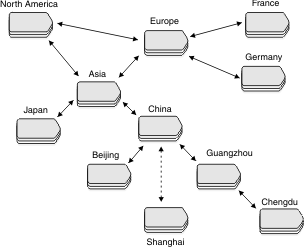Forest of trees topology

In Forest-of-Trees Topology , North America, Asia, and Europe are root database servers. That is, they are fully connected with each other. France and Germany are in a tree whose root is Europe. Asia is the root for the six database servers in its tree.
In a forest of trees, all replication messages from one tree to another must pass through their roots. For example, a replication message from Beijing to France must pass through China, Asia, and Europe.
Organizing the database servers in a hierarchical tree or a forest of trees greatly reduces the number of physical connections that are required to make a replication system. If all the database servers in Forest-of-Trees Topology were fully connected, instead of being organized in trees, 55 connections would be required.
To ensure that all servers retain access to the replication system, use high-availability clusters on parent servers. For more information, see Using high-availability clusters in a forest of trees topology.